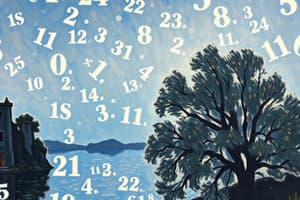Podcast
Questions and Answers
What is the factorial of 4?
What is the factorial of 4?
If you have three colors (red, blue, and green), and you want to arrange them in a row where order matters, what concept should you use?
If you have three colors (red, blue, and green), and you want to arrange them in a row where order matters, what concept should you use?
What is the formula for calculating permutations of n distinct items?
What is the formula for calculating permutations of n distinct items?
When does one use combinations instead of permutations?
When does one use combinations instead of permutations?
Signup and view all the answers
What is the formula for calculating combinations of $n$ distinct items taken $r$ at a time?
What is the formula for calculating combinations of $n$ distinct items taken $r$ at a time?
Signup and view all the answers
What is the number of ways to form groups of four people from a group of eight known as?
What is the number of ways to form groups of four people from a group of eight known as?
Signup and view all the answers
What does $P(4)$ represent in the context of arrangements?
What does $P(4)$ represent in the context of arrangements?
Signup and view all the answers
How many ways can you arrange 8 distinct items in a specific order?
How many ways can you arrange 8 distinct items in a specific order?
Signup and view all the answers
What type of function is both one-to-one and onto?
What type of function is both one-to-one and onto?
Signup and view all the answers
In mathematics, what do we call functions that are one-to-one?
In mathematics, what do we call functions that are one-to-one?
Signup and view all the answers
Which field heavily relies on functions to model relationships between inputs and outputs?
Which field heavily relies on functions to model relationships between inputs and outputs?
Signup and view all the answers
What defines the domain of a relation or function?
What defines the domain of a relation or function?
Signup and view all the answers
Which type of relation is reflexive, symmetric, and transitive?
Which type of relation is reflexive, symmetric, and transitive?
Signup and view all the answers
What property do Injective (One-to-one) functions exhibit?
What property do Injective (One-to-one) functions exhibit?
Signup and view all the answers
In Surjective (onto) functions, what do they map?
In Surjective (onto) functions, what do they map?
Signup and view all the answers
Study Notes
Permutations and Combinations: A Primer on Factorial Notation, Permutations, and Combinations
Imagine you're hosting a dinner party and have four guests to invite from a group of eight people. You might be curious about how many different ways you can form groups of four (without worrying about the order). Or perhaps you're a programmer, trying to calculate the variety of outcomes for a certain algorithm. This is where the fascinating world of permutations and combinations comes into play, helping us understand and solve problems like these.
Factorial Notation
To grasp permutations and combinations, we first need to understand the concept of factorial notation, represented by an exclamation point (!). Factorial (n!) of a positive integer (n) is the product of all positive integers up to (n). For example, (4!) is (4\times3\times2\times1=24).
Permutations
A permutation is an arrangement of a given set of items where the order matters. For example, if you have three colors—red, blue, and green—and want to know the number of ways to arrange them in a row, a permutation is what you're looking for.
The formula for calculating the number of permutations of (n) distinct items (P(n)) is given by:
[ P(n) = n! ]
For instance, if you have four guests and want to know the number of ways to arrange them, (P(4) = 4!) equals 24.
Combinations
A combination, on the other hand, is an arrangement of a given set of items where the order does not matter. For example, if you want to know the number of ways to form groups of four people from a group of eight, a combination is what you need.
The formula for calculating the number of combinations of (n) distinct items taken (r) at a time (C(n,r)) is given by:
[ C(n, r) = \frac{P(n)}{P(r)} = \frac{n!}{r!(n-r)!} ]
For instance, if you have eight people and want to know the number of ways to form groups of four, (C(8,4)) equals 70.
Putting It All Together
Now, let us apply these concepts to our dinner party example.
- Calculate the number of ways to arrange four guests out of eight: (P(4) = 4!) equals 24.
- Calculate the number of ways to form groups of four people from a group of eight: (C(8,4)) equals 70.
These numbers provide you with the answers to your questions: 24 ways to arrange the guests in a specific order and 70 ways to form groups of four people without worrying about order.
Understanding permutations and combinations can be a game-changer for those seeking to improve their problem-solving skills and expand their mathematical knowledge. With the help of factorial notation, permutations, and combinations, you can excel at puzzles, games, and even analyze real-world scenarios!
Studying That Suits You
Use AI to generate personalized quizzes and flashcards to suit your learning preferences.
Description
Learn about permutations and combinations, including factorial notation, how to calculate permutations and combinations, and how they differ. Discover the fascinating world of arranging items and forming groups where the order matters or doesn't matter.




